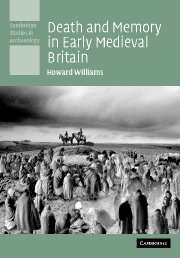7 - Remembering, forgetting and the mortuary context
Published online by Cambridge University Press: 22 September 2009
Summary
Introduction
From the discussion of previous chapters, we have seen how different elements of the materiality of early medieval death were employed in remembering and forgetting the dead, and we have seen instances of how these formed a part of strategies of commemoration in different times and places. This book has introduced a new theoretical argument concerning how we investigate the relationships between death, memory and material culture in early medieval Britain. Artefacts, the body, graves, monuments and landscape have been explored in terms of their roles in remembering and forgetting.
In many ways, this book does not break any moulds, focusing within accepted period boundaries of the fifth and eleventh centuries, without charting the many themes linking the societies and mortuary practices on either side of these chronological parameters. Equally traditional is the focus on Britain, without consideration of Ireland, Scandinavia or Continental Europe. A further emphasis has been upon the evidence from cemeteries and an avoidance of detailed discussions of settlements and other archaeological contexts, again a consequence of the space available and the questions asked. However, taking the argument further in time, space and context would require more research and space than is possible here. Within this traditional period and geographical division, the book has attempted to explore thematically a range of different archaeological sites, many of which have not been discussed in archaeological syntheses.
- Type
- Chapter
- Information
- Death and Memory in Early Medieval Britain , pp. 215 - 221Publisher: Cambridge University PressPrint publication year: 2006

